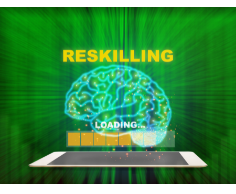6 min read
Essential Facilitation Skills for Thriving in Hybrid Learning
 Jennifer Hofmann
:
Sep 5, 2024 8:00:00 AM
Jennifer Hofmann
:
Sep 5, 2024 8:00:00 AM

As organizations increasingly rely on virtual classrooms to upskill and reskill their teams, the role of the virtual facilitator has become a cornerstone of successful learning experiences. In a world where connection and engagement can be challenging to achieve through a screen, the ability of a facilitator to thrive in their role is crucial. Thriving as a virtual facilitator means more than just managing technology—it involves creating dynamic, inclusive, and impactful learning environments where every participant feels connected and engaged, regardless of their location. By mastering the essential skills outlined here, facilitators can not only excel in their roles but also empower their learners to achieve their full potential in the virtual classroom.

To excel as a virtual facilitator, it’s essential to master key competencies across three core areas:
- Cultivate A Leaner Centric Environment
- Seamlessly Integrate Technology
- Manage the Hybrid “Room”
[Download our worksheet: 19 Essential Virtual Facilitation Skills: Self-Assessment and elevate your own performance today.]
Cultivate A LeaRner Centric Environment
In a hybrid learning environment, where participants may engage both virtually and in-person, putting the learner first is more critical than ever. This competency ensures that all participants, regardless of their location, feel valued, heard, and connected to the learning process. By focusing on the needs and experiences of each learner, facilitators can bridge the gap between different learning environments, creating a cohesive and inclusive experience. This approach not only enhances engagement but also drives better learning outcomes by making the content relevant and accessible to everyone involved.
- Listen to All Learners: Inclusivity is crucial in a hybrid setting. Create opportunities for every participant—whether they are online or in-person—to contribute and share their perspectives. This approach enriches the learning experience with diverse viewpoints and fosters a sense of belonging among all learners, ensuring that no one feels left out or marginalized.
Make sure you also listen to all forms of communication. Chat, private messaging, audio, video-preference are all legitimate forms interaction, and should be treated as equally. - Listen Actively: Active listening involves genuinely understanding and responding to the needs and concerns of both virtual and in-person participants. Provide thoughtful feedback, address queries promptly, and acknowledge contributions from all learners. This builds a supportive environment that encourages deeper engagement and learning.
- Connect Content to Learners: Tailor the content to link directly with learners' experiences and professional goals, whether they are participating remotely or in the classroom. This relevance makes the learning process more motivating and applicable. Use our Question Framing Guide to design questions and activities that provoke thoughtful discussions and make content relatable to diverse learners.
- Foster Peer Connections: Encourage collaboration between virtual and in-person participants. Facilitate group activities and discussions that enable learners to interact and learn from each other, creating a unified learning community. Use breakout rooms and collaborative tools to bridge the gap between different learning environments and promote shared understanding.
- Demonstrate Cultural Competence: Be aware of and sensitive to the diverse cultural backgrounds of your learners. Adapt your facilitation style to respect and incorporate these diverse perspectives, enhancing the learning experience for everyone. This includes recognizing and addressing cultural differences in communication and learning preferences.
- Be Inclusive: Adapt your facilitation methods to ensure that all participants, regardless of their background or learning environment, feel included. This involves using inclusive language, providing varied materials and resources, and ensuring that all voices are heard and valued.
- Be Comfortable Addressing Bias: Actively identify and address any unconscious biases that may impact interactions and learning outcomes. Create an environment where all learners feel respected and understood, and take steps to mitigate any biases that could affect their experience or participation.
By prioritizing these aspects, you create a hybrid learning environment where every participant can thrive, leading to more effective and impactful learning experiences.
Seamlessly Integrate Technology
Effectively integrating technology is critical for maintaining a cohesive and engaging learning experience, especially in a hybrid classroom. Technology not only facilitates communication and content delivery but also serves as a powerful tool for enhancing interaction and engagement. However, when technology is not used effectively or fails, it can create disruptions and disengagement. Mastering the integration of technology ensures that both remote and in-person learners remain connected and actively participate in the learning process.
- Master Interactive Tools: Incorporate a variety of interactive tools to boost engagement and participation. Use features such as polls, breakout rooms, and interactive whiteboards to create a dynamic virtual environment. For example, polls can gauge understanding in real-time, breakout rooms can facilitate small group discussions, and interactive whiteboards can encourage collaborative problem-solving. This approach keeps both virtual and in-person participants actively involved and connected.
- Leverage Technology for Engagement: Use technology as a strategic tool to enhance engagement. Incorporate elements like gamification, digital simulations, and real-time collaboration platforms to make learning more interactive and engaging. Gamification can include quizzes with leaderboards or point systems, while digital simulations can provide hands-on practice in a virtual setting. Real-time collaboration tools allow learners to work together on projects or activities, bridging the gap between different learning environments.
- Demonstrate Digital Fluency: Navigate and utilize virtual platforms with ease to set a standard of competence. Model effective use of digital tools and address technical issues swiftly to minimize disruptions. When technology is used proficiently, it enhances engagement by ensuring smooth and uninterrupted delivery of content.
- Promote Digital Literacy: Equip learners with the digital skills necessary to engage with technology effectively. Provide guidance and practice opportunities to help them become comfortable with the tools used during sessions. When learners are confident in their use of technology, they are more likely to participate actively and engage with the content. Support and resources should be available to address varying levels of digital proficiency.
- Incorporate Advanced Features: Explore and integrate advanced features of virtual platforms and additional software to enrich the learning experience. Advanced tools such as virtual reality, augmented reality, and sophisticated analytics can enhance engagement by providing immersive and interactive learning experiences. For instance, virtual reality can simulate real-world scenarios, making the learning experience more tangible and engaging.
- Address and Troubleshoot Tech Problems: Develop skills for swiftly resolving complex technical issues to prevent disruptions. When technology fails or is not used effectively, it can lead to disengagement and frustration among participants. Be prepared with troubleshooting strategies and backup plans to minimize the impact of technology failures on the learning experience. Ensure that all participants, whether remote or in-person, have the support they need to stay engaged and focused.
For some more practical tips, check out our Quick Reference Guide: Top 10 Tips for Integrating Learning Technology.
By effectively integrating technology and using it strategically to enhance engagement, you create a hybrid learning environment that is interactive, inclusive, and seamless. This approach not only improves the learning experience but also helps prevent the disengagement that can result from poor technology use or technical issues.
Manage the Hybrid “Room”
Managing the hybrid "room" is a crucial skill for virtual facilitators in today's learning environments. The hybrid model presents unique challenges, such as keeping both in-person and remote learners engaged, ensuring equitable participation, and seamlessly integrating technology into the learning experience. To effectively manage the hybrid "room," facilitators must be adept at commanding presence, managing time, and adapting to the diverse needs of their participants.
- Command Virtual Presence: Cultivate a strong virtual presence that resonates with both in-person and remote learners. Use your voice and visual presence to maintain energy and engagement, carefully modulating tone and pacing. Ensure a professional on-camera appearance to keep remote learners focused, while also addressing in-person participants to create a cohesive and unified experience.
- Effectively Manage Time: In a hybrid setting, balancing thorough exploration of topics with time constraints is more critical than ever. Efficiently manage live sessions by considering the different paces at which in-person and remote participants engage. Allocate time for preparation, including testing technology, and for post-session reflection to ensure high-quality delivery for all learners.
- Apply Adult Learning Principles: Respect the experiences and autonomy of adult learners by focusing on practical application and relevance. This approach is particularly vital in hybrid environments, where remote participants may require additional support to stay engaged.
- Handle Unplanned Scenarios: Hybrid environments can be unpredictable, often presenting technical issues or varying levels of engagement. Manage unexpected challenges with composure, and adjust your approach based on real-time feedback from both in-person and remote participants. This adaptability ensures that the session flows smoothly, even in the face of disruptions.
- Adjust Content Delivery: Flexibility is key in hybrid settings. Be prepared to modify your delivery approach to meet the evolving needs of the group, using different tools or techniques to ensure that content remains accessible and engaging for all participants, whether they are in the room or joining remotely.
- Demonstrate Emotional Intelligence: Recognize and address the emotional and motivational needs of all participants. Hybrid environments can create unique emotional challenges, so it's essential to provide support with empathy, ensuring that both in-person and remote learners feel valued, included, and engaged.
By mastering the ability to manage the hybrid "room," facilitators can create a learning environment where every participant, regardless of their location, feels connected and engaged. This skill is essential for delivering a seamless and impactful learning experience.
Strive to Thrive
Becoming an exceptional virtual facilitator requires continuous growth, adaptability, and a commitment to thriving in a dynamic environment. By mastering the 19 essential skills, you position yourself not just to manage, but to excel in the virtual classroom. Thriving as a facilitator means consistently delivering high-quality, engaging, and impactful learning experiences that resonate with every participant. This journey involves staying informed about the latest techniques, tools, and theories, seeking feedback, and embracing opportunities for professional development. As you thrive in your role, you set a powerful example for your learners, inspiring them to engage fully and achieve their own success in the virtual learning landscape. Your dedication to mastering these skills ensures that you can create a thriving, connected, and inclusive learning environment that empowers everyone involved.
Download our worksheet: 19 Essential Virtual Facilitation Skills: Self-Assessment and elevate your own performance today.
Ready to actively develop your virtual facilitation skills and truly thrive in the hybrid virtual classroom? Enroll in our accredited Virtual Classroom Facilitation Mastery course and gain the tools, techniques, and confidence you need to lead dynamic, impactful learning experiences. Start your journey to becoming an exceptional virtual facilitator today.

5 Core Strategies and Tactics for Effective Virtual Classroom Programs
Upskilling the “new normal” virtual world is no longer a “nice to have” but a matter of survival. Many facilitators learned the hard truth that...

1 min read
Cultivating an Analytical Mindset in L&D
One of the key qualities of anyone involved in L&D is having an analytical mindset. It is crucial for the continuous improvement of learning...
